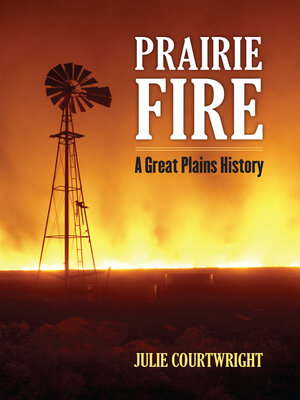
Sign up to save your library
With an OverDrive account, you can save your favorite libraries for at-a-glance information about availability. Find out more about OverDrive accounts.
Find this title in Libby, the library reading app by OverDrive.



Search for a digital library with this title
Title found at these libraries:
| Library Name | Distance |
|---|---|
| Loading... |
A Kansas Notable Book
Prairie fires have always been a spectacular and dangerous part of the Great Plains. Nineteenth-century settlers sometimes lost their lives to uncontrolled blazes, and today ranchers such as those in the Flint Hills of Kansas manage the grasslands through controlled burning. Even small fires, overlooked by history, changed lives—destroyed someone's property, threatened someone's safety, or simply made someone's breath catch because of their astounding beauty.
Julie Courtwright, who was born and raised in the tallgrass prairie of Butler County, Kansas, knows prairie fires well. In this first comprehensive environmental history of her subject, Courtwright vividly recounts how fire—setting it, fighting it, watching it, fearing it—has bound Plains people to each other and to the prairies themselves for centuries. She traces the history of both natural and intentional fires from Native American practices to the current use of controlled burns as an effective land management tool, along the way sharing the personal accounts of people whose lives have been touched by fire.
The book ranges from Texas to the Dakotas and from the 1500s to modern times. It tells how Native Americans learned how to replicate the effects of natural lightning fires, thus maintaining the prairie ecosystem. Native peoples fired the prairie to aid in the hunt, and also as a weapon in war. White settlers learned from them that burns renewed the grasslands for grazing; but as more towns developed, settlers began to suppress fires-now viewed as a threat to their property and safety. Fire suppression had as dramatic an environmental impact as fire application. Suppression allowed the growth of water-wasting trees and caused a thick growth of old grass to build up over time, creating a dangerous environment for accidental fires.
Courtwright calls on a wide range of sources: diary entries and oral histories from survivors, colorful newspaper accounts, military weather records, and artifacts of popular culture from Gene Autry stories to country song lyrics to Little House on the Prairie. Through this multiplicity of voices, she shows us how prairie fires have always been a significant part of the Great Plains experience-and how each fire that burned across the prairies over hundreds of years is part of someone's life story.
By unfolding these personal narratives while looking at the bigger environmental picture, Courtwright blends poetic prose with careful scholarship to fashion a thoughtful paean to prairie fire. It will enlighten environmental and Western historians and renew a sense of wonder in the people of the Plains.







